 |
 |
 |
http://www.varalaaru.com A Monthly Web Magazine for South Asian History [187 Issues] [1839 Articles] |
 |
 |
 |
http://www.varalaaru.com A Monthly Web Magazine for South Asian History [187 Issues] [1839 Articles] |
|
Issue No. 56
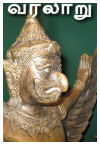
இதழ் 56 [ ஃபிப்ரவரி 24 - மார்ச் 15, 2009 ] 
இந்த இதழில்.. In this Issue.. 
|
Series:
Pudukkottai Cave Temples
From the corridor one can reach the western side of the mandapa through the steps arranged in the front. Comparing to the eastern side the mandapa in the west is little higher in floor level and also fully closed. The Banu Umapathiswara shrine is seen in the middle facing east. Behind this shrine there are two pairs of small sanctums. The pair in the south is dedicated to Vinayaga and Siva, whereas the pair in the north houses Gajalakshmi and Subramanya. To the north of Banu Umapathiswara shrine a small shrine for Chadikeswara is seen facing south.
 The Corridor That Leads To The Mandapa In The West All the four shrines are similar with features of padabanda adhistana, wall sectioned by pilasters and with the usual prastara elements. Each pair has a common front wall with separate entrances flanked by a pair of pilasters and a flight of two steps arranged in the front. The enclosure wall of the mandapa forms the back wall of the sub-shrines. Entrances are flanked by twin pilasters and the potikas are vettu in style. The door jambs are festooned as lotus petals. Each pair has a single crown of vesara type, which is shown above the roof of the mandapa. The pair in the south has shikara above the Vinayaga shrine whereas the pair in the north has shikara above the Subramanya shrine. 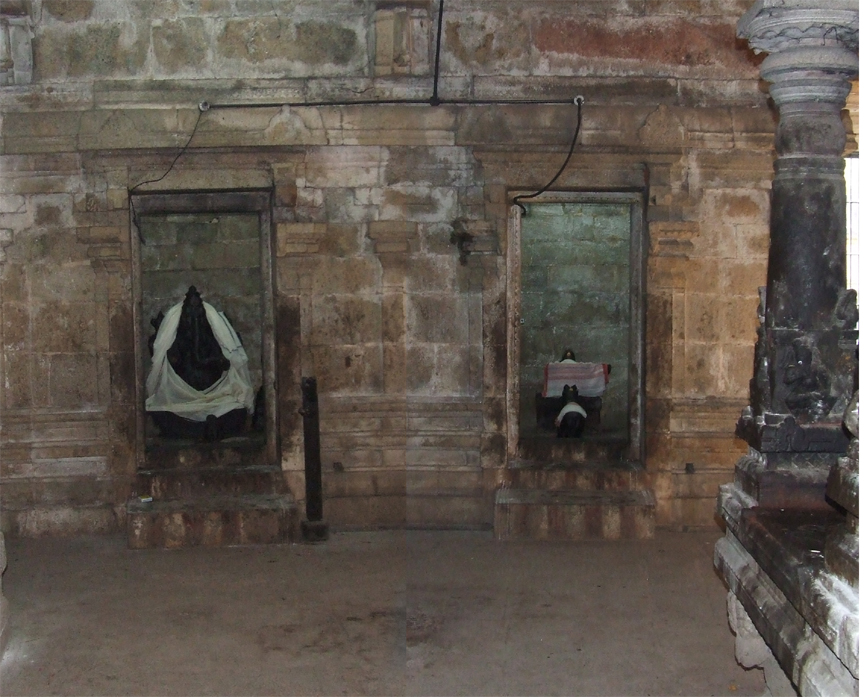 The Twin Shrines In The South 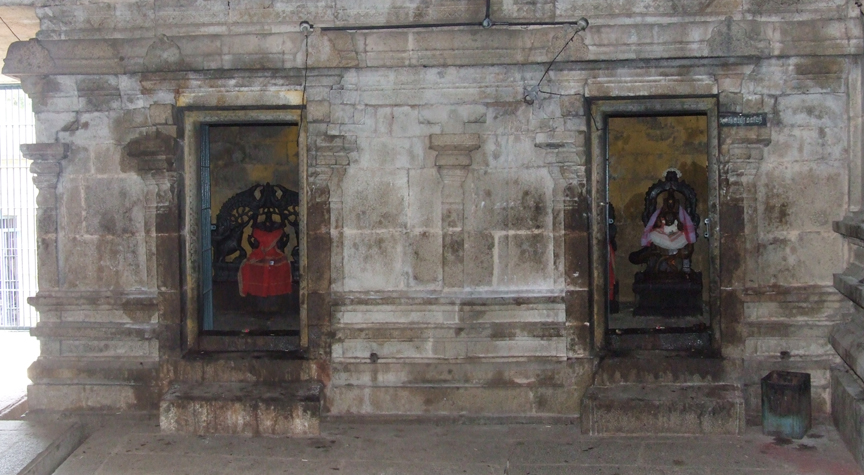 The Twin Shrines In The North Vinayaga in lalithasana with front hands in abaya and vara and the back hands holding pasa and angusa, karanta makuta adorns the head. A small linga is seen in the adjacent cell with a nandi facing the Lord. Gajalakshmi is seated in a pedestal in suhasana with rampant elephant on either side. An ornamental thiruvasi is shown behind the deity, in which, on either side the festoons flowing from the mouth of the makaras forms the arch. In the apex a pair of birds are shown pecking the tail of the makaras. The scrolls shown in between the arch and elephant is ornamental like a filigree work. Next is seen Subramania seated on a peacock in suhasana, peacock standing on a pedestal. The front hands are in abaya and vara whereas the back hands are holding sakthi and vajra. A thiruvasi is shown behind the deity. His consorts Valli and Deivanai are seen standing on a separate pedestal on either side. 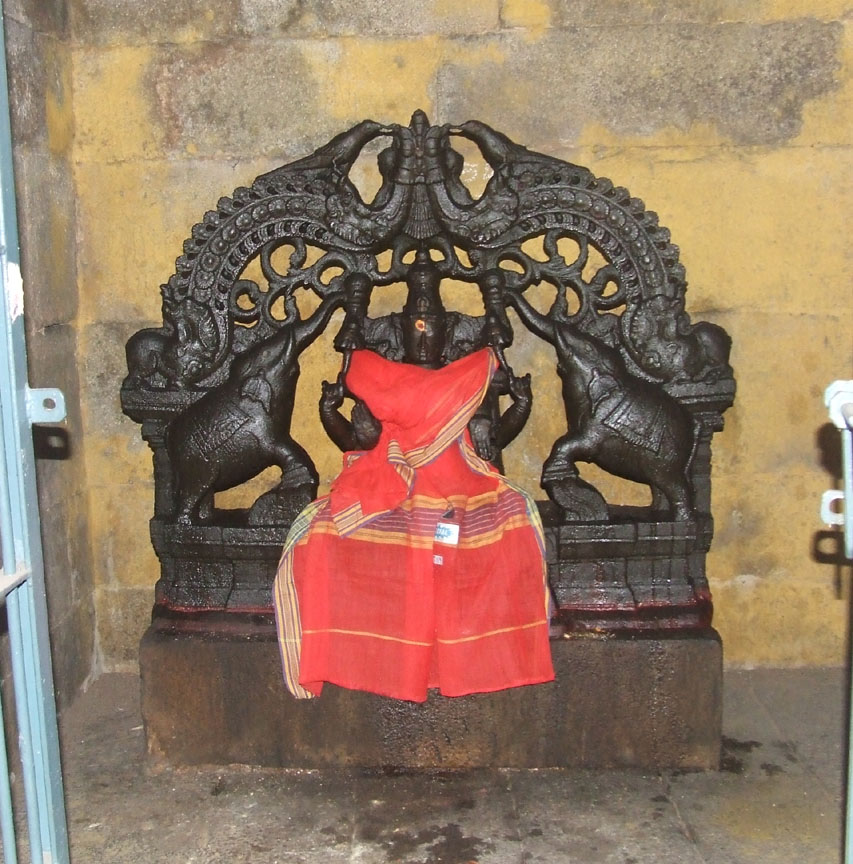 Gajalakshmi 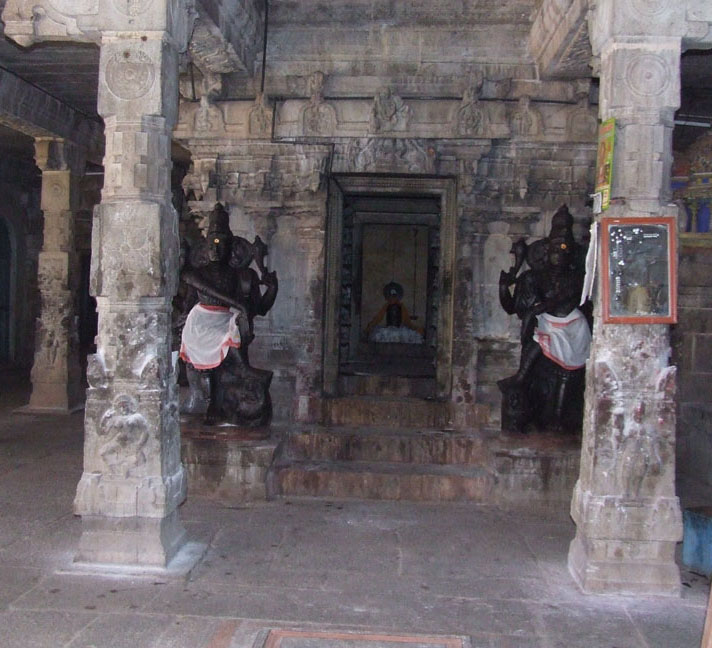 The Banu Umapathiswara Shrine In the center of the western mandapa is seen the Banu Umapathiswara shrine. It consists of a sanctum and a mukhamandapa in which Siva in the form of Linga adorns the sanctum. The vimana is a three tier structure which is nagara in style with vesara crown. The vimana has a padabandha basement and above it raises the wall sectioned by pilasters. In between the basement and wall is shown the vedika component. The karna and the sala sections are in linear arrangement without any projection for salabadhra. The pilasters are decorative with the features of upapitha base with kapota and kudu arches as its upper element and above it raises the usual pilaster, which is shown with all its ornamental upper elements. The potikas above the pilasters are madalai and nanudal tipped with sharp bud. The above raising madalais are holding the uttira, vajana and valabhi. The valabhi is decorated as padmavari. The kapota has well formed kudu arches, which flows from the mouth of simha. The kudus are adorned with miniatures of interesting figures. Above it is seen bhumidesa with makara heads in the corners. The first tala is inside the mandapa and the upper two tiers of the vimana are seen above the roof of the mandapa. The upper tiers are fully adorned with sculptures of interesting theme. 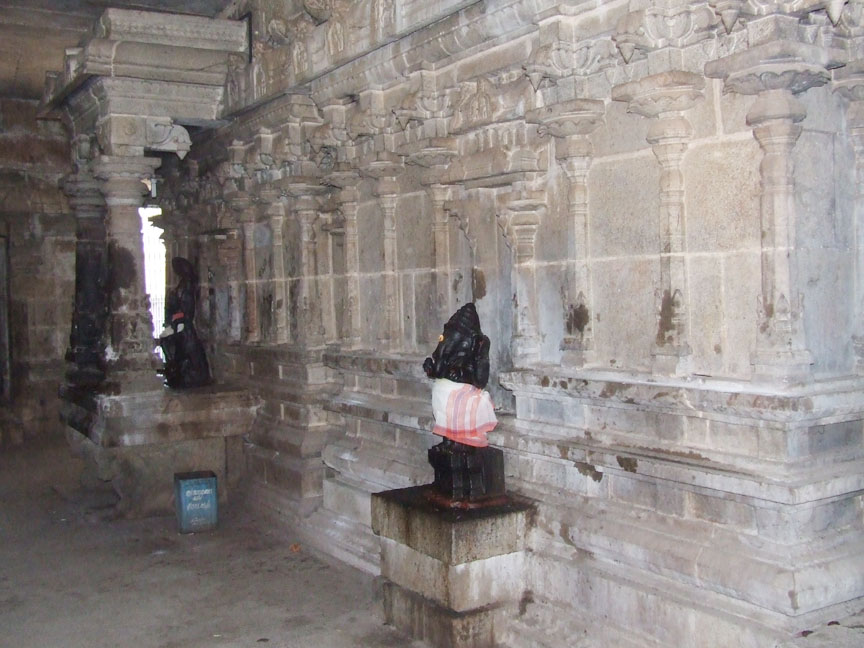 The Niches In The South The same symmetry is seen for the ardhamandapa. In between the ardhamandapa and the sanctum a recession is shown in which a pilaster crowned by sala shikara is seen. The sala sections on all the three sides except east are adorned with niches. The niches are decked with deities. Ganesa and Dakshinamurthy is seen in the south, Lingothbava in the west and Brahma and Durga in the north. The deities are kept on a separate pedestal in front of the niches.  The Niches In The South 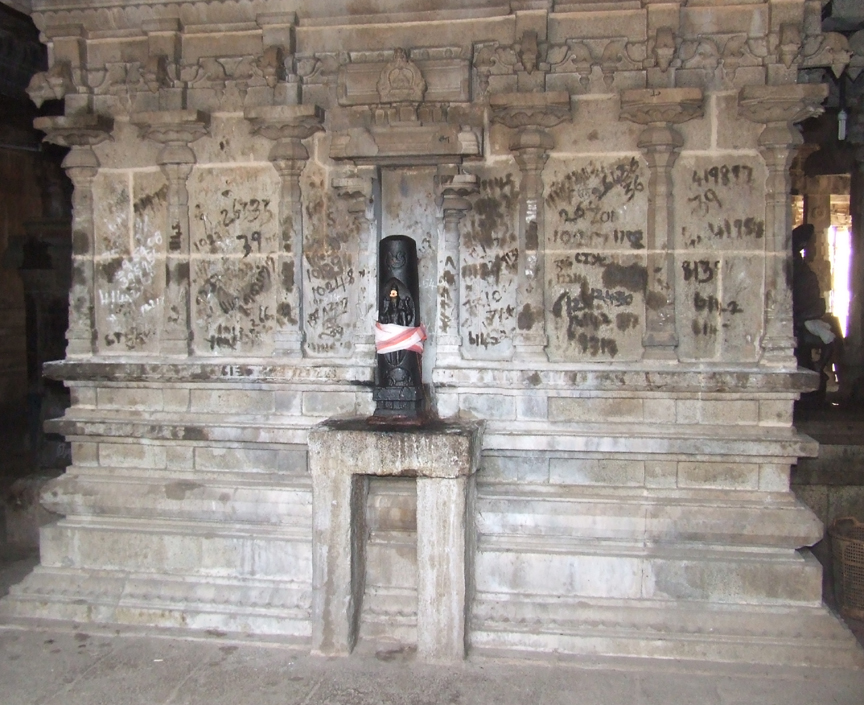 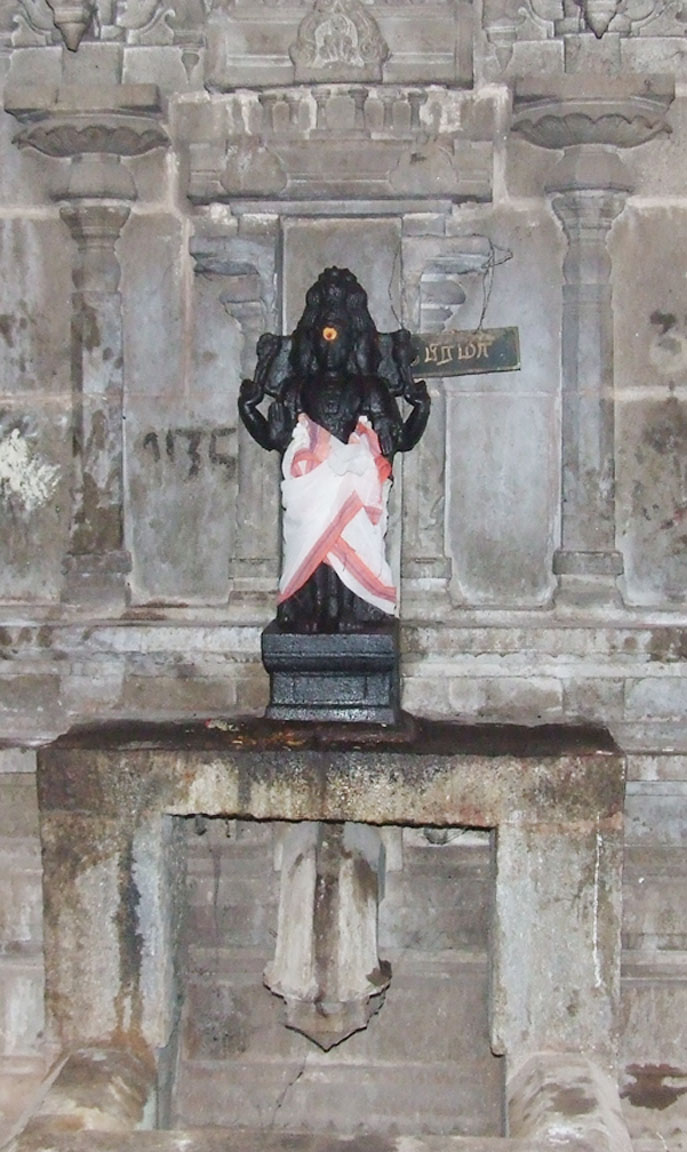 The Niche In The West And North The niche of Dakshinamurthy is shown with additional embellishment. The deity is placed in a pedestal, which is bared, by two sprawling simhas. The pedestal is decorated as upapitha with kapota decked with kudus as upper elements. Two rudra pillars are shown in the front. The squares of the pillars are adorned with miniatures of sages in meditating posture. The rudra pillars have the upper elements of kattu, kalasa, tadi, kudam, padmapali, palakha and veerakanda. The potikas are madalai and nanudal, which are shown only on the inner sides. Above the potikas are seen the uttira, vajana and valabhi with padmavari, kapota with kudu arches. 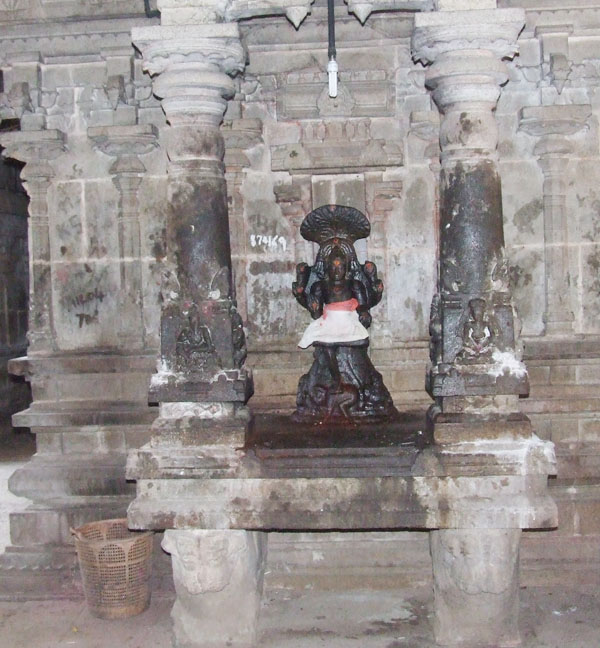 Dakshinamurthy The deity is shown seated on a hillock in suhasana by trampling muyalaga on his right foot. Rishis are shown around the mound either in meditation or listening to the preaching of the deity. The tree behind the God is shown as an awning. The head is decorated as jatabara in which separate locks arranged together to form the jatabara. The front right hand is in abaya and the front left hand is carrying the palmleaf whereas the back right hand is holding snake and back left hand is holding pasa. The right ear is elongated and decked with makarakundala whereas the left ear is with patrakundala. 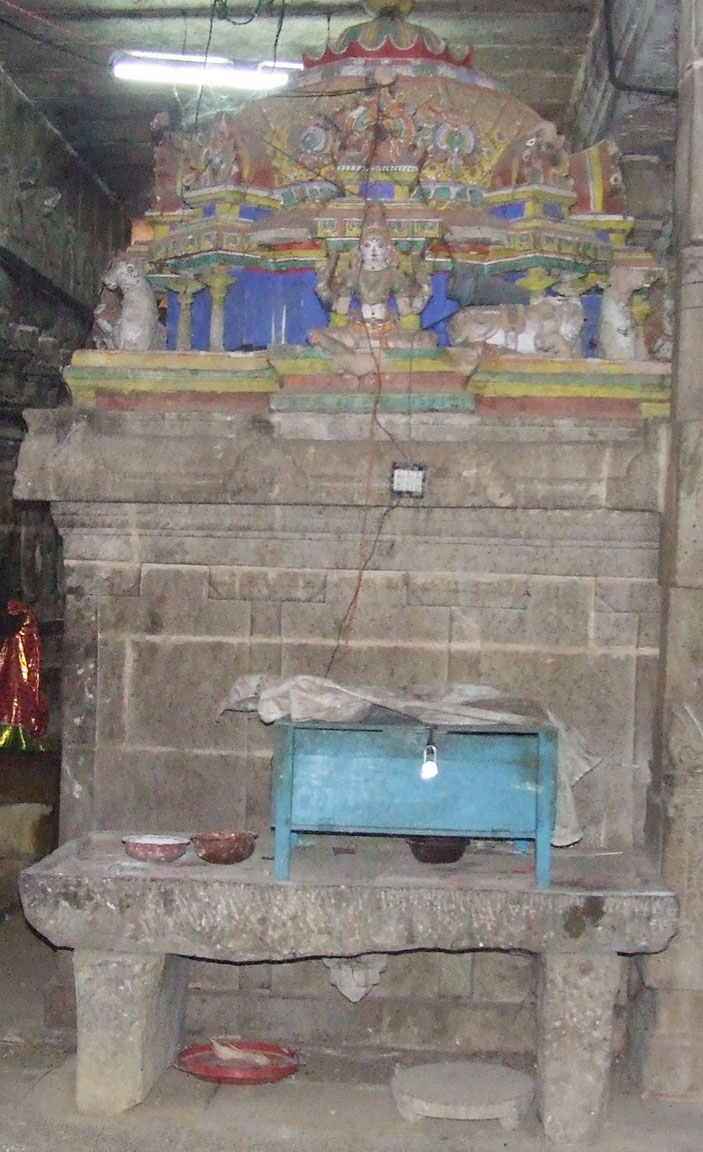 The Chandikeswara Shrine In The South The miniatures in the kapota kudus are the interesting features to note. Some of the miniatures depicts the mythological themes like Kannappar, Krishna dancing on Adhisesha, Linga with the cow, dancing Siva etc. squatting lion, monkey, goddess with flower, Krishna, Linga, Vinayaga are also seen. The miniature of dancing Siva, which is seen above the entrance, is an interesting figure to note. Siva is dancing in urthuvajanu accompanied by Brahma to His left and Nandi with drum to His right. Kali in dancing posture is seen in another kudu above the entrance. 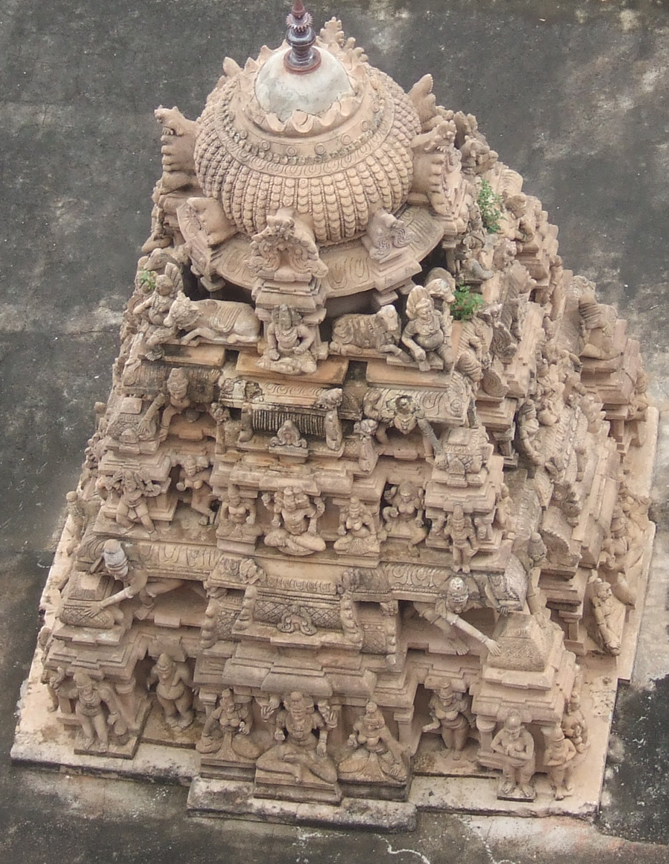 The Vimana Of Banu Umapathiswara Shrine In front two dvarapalakas are seen guarding the shrine. A flight of three steps arranged in the front leads us to the ardhamandapa. The door jambs are very decorative with miniature carvings. Above the entrance a fine miniature of Gajalakshmi is seen in the lintel. The sanctum houses the deity Banu Umapathiswara in the form of Linga. we see the inner mandapa in the next edition. this is txt file� |

சிறப்பிதழ்கள் Special Issues 

புகைப்படத் தொகுப்பு Photo Gallery 
|
| (C) 2004, varalaaru.com. All articles are copyrighted to respective authors. Unauthorized reproduction of any article, image or audio/video contents published here, without the prior approval of the authors or varalaaru.com are strictly prohibited. | ||